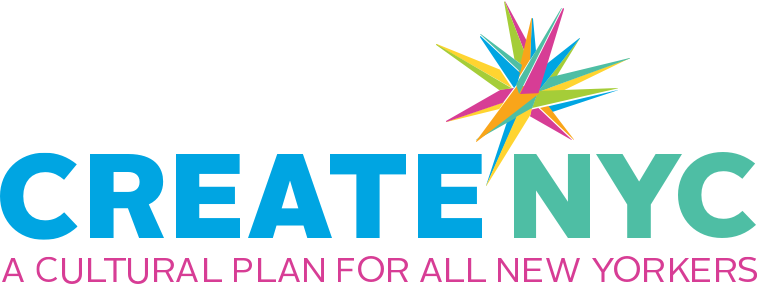The single most common appeal during the cultural planning process was for more arts education—more in quantity, quality, diversity, and affordability. In fact, 85% of CreateNYC survey respondents stated that arts, culture, and science education were important to their child’s education.
New Yorkers intuitively understand the value and can see results for their children, for themselves, and for the city overall. And perhaps the most common thrust of arts advocacy is that while arts education is inherently valuable, it also sows the seeds for achievement across disciplines.
“Everybody wants more festivals and places for children to play and learn.”
SALMA
RESIDENT, BROOKLYN
A COMMITMENT TO EXPAND ARTS EDUCATION INVESTMENTS
In a 2005 Harris poll, 93% of Americans agreed that the arts are vital to providing a well-rounded education for children. An analysis sponsored by the National Endowment for the Arts in 2012 revealed that teenagers and young adults of low socioeconomic status with a history of in-depth arts involvement showed significantly better academic outcomes than kids from similar backgrounds who have less arts involvement. The 2017 Social Impact of the Arts Project (SIAP) report indicated that higher cultural participation in low-income neighborhoods is a predictor of higher student performance. The conclusion is clear: arts and science education are critical for our students, and New Yorkers want more.
landscape varies significantly across the city. A 2014 report by the New York City Comptroller revealed large gaps in the provision of arts instruction and a general decline in overall arts education funding for the city’s
1.1 million public school students. According to the same data, schools in lower income areas of the city were disproportionately impacted by these cuts. A nuance to this research was found in a subsequent study of arts education opportunities, grades 1-4, conducted by the CUNY Graduate Center’s Center for Urban Research, which revealed that no consistent, direct link existed between poverty and the amount of arts education received by students. Rather, the stronger correlation is between schools with a high percentage of English Language Learners (ELLs) who receive less arts education opportunities in grades 1 through 4.
Since then, the City has significantly increased its investment in arts education. During the 2015-16 academic year alone, Mayor de Blasio and the City Council made a historic commitment of $92 million of new money for arts education over the next four years. This has allowed the Department of Education (DOE) to hire 300 more certified art teachers citywide and arts coordinators for each borough and address some of the gaps that have widened over the last decade.
As illustrated in the 2015-16 Arts in Schools Report, 98% of elementary schools teach at least one arts discipline with instruction provided by school-based arts teachers or classroom teachers, and 89% teach at least one arts discipline with instruction provided by cultural arts organizations. In middle schools, 98% of schools provide instruction in at least one discipline, and instruction by type of arts discipline has consistently increased over the past four years.
“The impact of arts education on my career is complete, total, and it saved my life.”
LIN-MANUEL MIRANDA
FORMER NEW YORK CITY STUDENT
Cultural organizations are a tremendous asset to New York City public schools. Students and teachers benefit from partnerships through field trips, in-school workshops, performances, exhibitions, residencies, and teacher professional development. Across all boroughs and grades, 87% of schools partner with at least one cultural arts organization, and Staten Island reports the highest rate, with 96% of schools in partnership with at least one organization.
Beyond what the DOE provides, DCLA is already a significant contributor to arts education in public schools. 1,935,755 visits to Cultural Institutions Group members by public school students in the 2015-16 academic year, with an additional 62,000 students served through Urban Advantage. Over 50% of DCLA’s Cultural Development Fund (CDF) grantees include arts education in the programming supported by public funds. These education programs range from in-school arts residencies, to public performances, to cultural class trips, to afterschool arts programs.
SCIENCE-BASED CULTURAL ORGANIZATIONS
Through robust partnerships with the city’s great cultural-based science institutions, New York City school children and community members are provided with a variety of hands-on science education opportunities within the city’s historic living collections.
Wildlife Conservation Society (WCS) and the Bronx Zoo offer immersive science-based learning for students grades Pre-K through 12, from urban ecology to poetry to exhibit design. Wildlife Theater brings WCS educators to schools citywide using theater to teach young people about natural sciences and helping to build the next generation of conservationists.
Brooklyn Botanic Garden (BBG) provides science-based learning experienced outside the classroom for students grade Pre-K through 8 from the study of flora—seeds to trees—to urban farming to scientific inquiry. At New York Botanical Garden, school field trips offer hands-on gardening, plant science workshops, and interactive environmental science lessons. Wave Hill, located in the Bronx, and Snug Harbor, in Staten Island, offer interactive, educational experiences to thousands of public school students in natural environments closer to home. Through the NYC Compost Project housed at science-based members of the Cultural Institutions Group and cultural organizations citywide, students and community members can participate in composting and recycling workshops.
AFTERSCHOOL AND OUT-OF-SCHOOL
The robust arts, culture, and science sectors in our city provide some of the most innovative and diverse afterschool and out-of-school arts programs across the five boroughs.
During the 2015-2015 academic year, the City Council’s Cultural Afterschool Adventures program (CASA), administered by DCLA, funded cultural partnerships at schools that served 19,855 students and employed 1,141 teaching artists in a broad range of arts disciplines. These partnerships help fill some of the gaps in arts education that existed during regular school hours. And with thanks to the City Council, CASA has grown significantly from its original allocation of $5 million in 2005, to $13.26 million in fiscal year 2018.
The New York City Department of Youth and Community Development (DYCD) provides engaging arts, culture, and science programming for youth during afterschool and out-of-school hours citywide. The Cornerstone Youth Program provides year-round programming at 94 NYCHA community centers citywide, and the Comprehensive After School System of New York City (COMPASS NYC) comprises more than 900 programs serving young people, grades K through 12, with arts, cultural, STEM, and other afterschool experiences provided by partner organizations. Presently, with increased support from Mayor de Blasio, COMPASS NYC is projected to serve 97,000 youth.
LEVERAGING PUBLIC FACILITIES FOR ARTS AND CULTURE
Department of Education data shows that almost 60% of New York City public high schools have 1-6 partnerships with cultural organizations, while 22% of schools have none. As shown by the map, high schools in neighborhoods identified by SIAP as having concentrated disadvantage (with respect to multiple dimensions of social wellbeing), particularly in parts of southern Brooklyn and Queens, report fewer partnerships with cultural organizations than those schools in other parts of the city. Increasing cultural partnerships in these areas can enhance the educational experience for both students and their families.
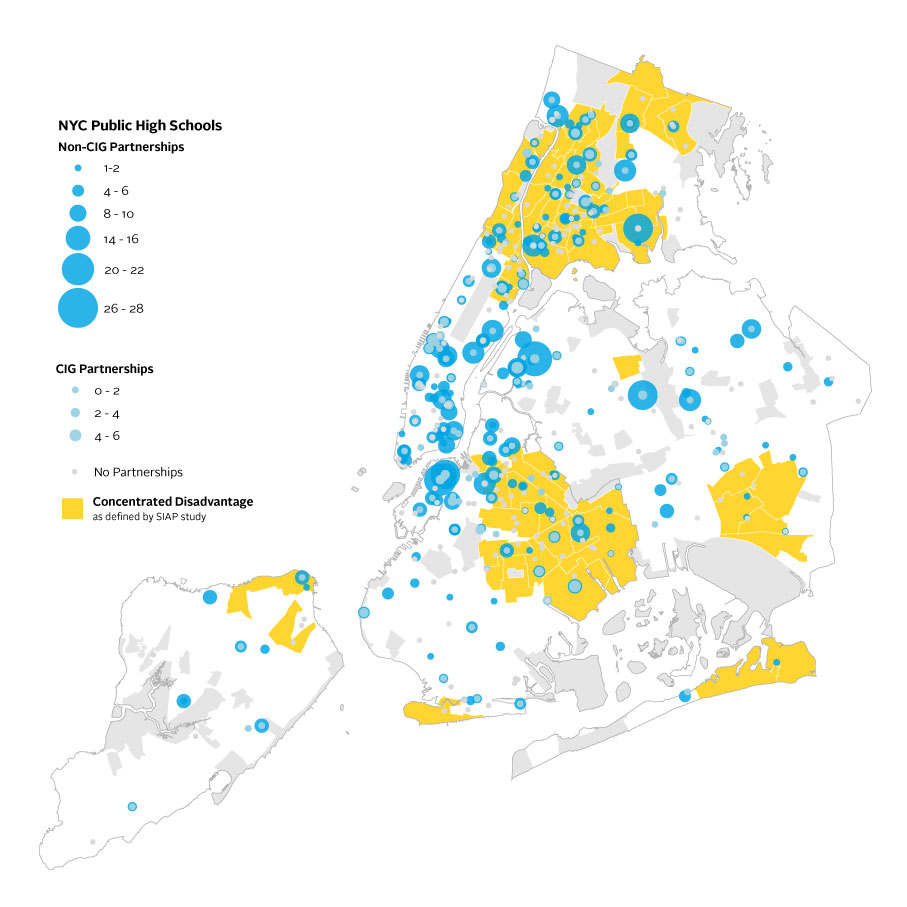
CULTURALLY RESONANT ARTS EDUCATION
At a CreateNYC focus group of Spanish-speaking immigrants at Make the Road, an immigrant rights group in Corona, Queens, parents stated their desire to expose their children to more mainstream arts and culture, while preserving their Spanish language and heritage. At a community-led workshop conducted in Mandarin, Cantonese, and Fuzhou by Btwn2Bridges in Chinatown for CreateNYC, one of the key recommendations was to empower local groups and organizations to preserve their heritage through the development of in- and out-of-school programs. Community priority for culturally relevant arts education, which is reflective of students and their families’ race, ethnicity, and cultural heritage is supported by objective research. For example, a 2017 Institute of Labor Economics study demonstrated that students of color who were taught by educators who shared the same race had better educational outcomes. Building on these types of findings, the City must work harder to increase the number of arts educators of color, with disabilities, and with non-binary gender identities and to provide more education opportunities that reaffirm our youths’ cultures as well as expand their knowledge of others.
“We need programs that promote the idea that everyone has creativity inside them, that everyone can be an artist.”
DAWOUD
PARENT
EXTENDED LEARNING
There is a vast world of extended learning for people of all ages and interests beyond what is available through our public schools, and our city’s residents take full advantage. At CreateNYC engagements in all five boroughs, the desire for more information on availability of affordable arts, culture, and science programs beyond school options was a recurring theme, and in a survey of 575 New Yorkers conducted by the Center for Arts Education, 79% of responders stated their family and friends would participate in more arts and cultural activities if they were free or less expensive.
Beyond what can be achieved in schools, we will look to our cultural partners to keep expanding and making accessible cultural offerings year-round. The nation’s largest creative aging program, for example, is here in New York. Now known as SU-CASA, the program is a partnership with the Department for the Aging (DFTA), DCLA, and local arts councils, funded by City Council. It places artists and cultural organizations in residence at senior centers across the city to provide participatory programming for older adults.
“We must make arts a norm subject, not a luxury”
JACQLENE
PARENT
A twelve-year study, published in 2009 by James Catterall, Doing Well and Doing Good by Doing Arts, found that arts-rich schools foster well-rounded achievement for students. “Intensive involvement in the arts during middle and high school associates with higher levels of achievement,” among other social benefits such as voluntarism and political participation. Educational opportunities offered through the city’s many cultural organizations—from birding at botanical gardens to creative writing at local bookshops—need continued support so they can continue to provide affordable options to students, their families, and lifelong learners, and employ scientists, teaching artists, and museum educators who keep New York City a world-renowned beacon of arts, culture, and science.
STRATEGIES
AE.1 Strengthen and promote high quality, diverse, and sequential art, culture, and science education for every child in New York City public schools
Continue to integrate arts and science education in Pre-K curricula.
TIMEFRAME: Short PARTNER(S): DOE
Enhance and expand arts education for English Language Learners (ELL) and students with disabilities (SWD). Support the provision of arts education by cultural organizations to these student populations in- and after-school time.
TIMEFRAME: Medium PARTNER(S): DCLA, DOE
Support arts instruction across grades K-12.
TIMEFRAME: Medium PARTNER(S): DCLA, DOE
Explore current pool of DOE arts educators for interest and commitment in securing new and/or additional certification in teaching ELLs or SWD in partnership with schools of education. Seek out opportunities to create complementary certification programs for arts education specialists with additional proficiencies such as teaching ELLs or SWD.
TIMEFRAME: Medium PARTNER(S): DCLA, DOE
AE.2 Diversify available city resources for arts, culture, and science-based organizations
Expand public school access to Materials for the Arts (MFTA) across all schools and organizations.
TIMEFRAME: Medium PARTNER(S): DCLA
Coordinate efforts across agencies to provide quality arts, culture, and science education during and after-school hours.
TIMEFRAME: Medium PARTNER(S): DCLA
Expand the availability of neighborhood spaces through school/CBO partnerships for cultural uses that benefit local families, educators, and artists.
TIMEFRAME: Long PARTNER(S): DCLA, DOE
AE.3 Invest in the longterm diversification of the arts, culture, and science fields
Share information for arts educators, administrators, teachers, teaching artists, and principals on inclusive, culturally resonant curricula and programming.
- Facilitate two-way learning between educators and/or teaching artists and the students and their families.
TIMEFRAME: Immediate PARTNER(S): DCLA, DOE
Broker introductions between cultural organizations and DOE public schools and district superintendents, to make possible more frequent school field trips and assemblies to learn about and celebrate cultures reflective of New York City’s diversity.
TIMEFRAME: Short PARTNER(S): DCLA, DOE
Clearly define and provide models for quality arts integration into other subjects for DOE leaders, educators, and arts and/or museum educators.
- Provide forums to introduce cultural organizations to the process of contracting to deliver services in- and afterschool.
- Encourage arts, culture, and science partnerships at the school level and encourage schools to think diversely and inclusively about which cultural partners provide services.
- Explore how to support, expand, and adapt models like DOE Summer in the City initiative, which incorporates visits to cultural organizations in summer school curriculum.
TIMEFRAME: Short PARTNER(S): DCLA, DOE, Cultural Community
Expand free and affordable afterschool arts and cultural programs citywide. Offer assistance to school administrators seeking culturally-relevant partners.
- Facilitate every school superintendent to develop relationships with arts, cultural, and science organizations.
- Continue to support and explore ways to adapt models like Teen Thursdays afterschool initiative, which brings middle school students to cultural organizations for hands on learning.
- Increase opportunities for artists to teach in afterschool programs.
TIMEFRAME: Medium PARTNER(S): DCLA, DOE
Partner with the city’s cultural organizations to support their work in training teachers and administrators and to educate students.
- Promote models like Urban Advantage, which partners science-based cultural organizations with public schools for learning opportunities, and other strategies.
TIMEFRAME: Medium PARTNER(S): DCLA, DOE
Support older adults and older artists as arts educators and teaching artists.
TIMEFRAME: Medium PARTNER(S): DCLA, DFTA, DOE, City Council
AE.4 Increase access to inclusive, culturallyresonant, and culturally responsive programming for students, older adults, and their families
Support programs that promote arts and culture career pipelines for individuals in underserved communities, such as DCLA/CUNY Cultural Corps.
TIMEFRAME: Medium PARTNER(S): DCLA, CUNY
Support professional development and fellowships for educators and teaching artists from underrepresented groups, including people with disabilities.
TIMEFRAME: Short PARTNER(S): DCLA, DOE
CASE STUDY
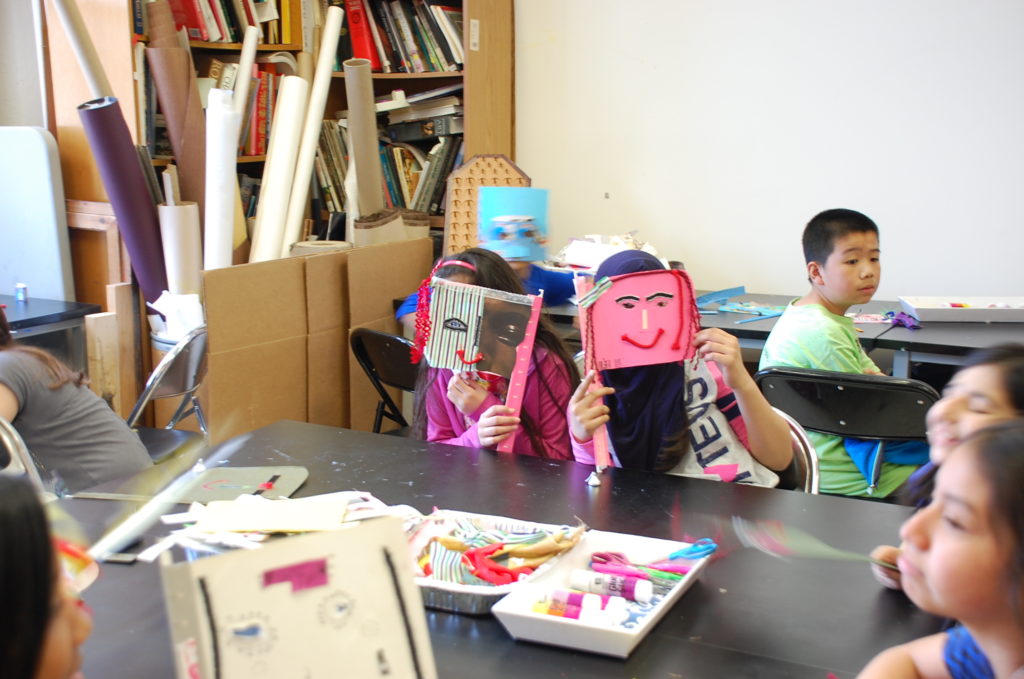
MATERIALS FOR THE ARTS
Founded in 1978, Materials for the Arts (MFTA)—DCLA’s model creative reuse and arts education program supported by a partnership with the DOE and the Department of Sanitation (DSNY—collects a wide variety of reusable materials and makes them available, free of charge, to New York City-based nonprofit organizations with ongoing arts programs, New York City public schools, and City agencies.
Annually, MFTA diverts nearly two million pounds of material from the waste stream that is reclaimed for creative reuse. In 2016 alone, MFTA member organizations obtained materials either through a warehouse visit or through MFTA’s online service more than 6,000 times. These supplies were valued at more than $9 million, and nearly 40% of these materials were used at New York City public schools. MFTA’s supply redistribution efforts include the August annual “Back to School” event providing classroom supplies to New York City public school teachers and when needed for emergency relief efforts, such as Hurricane Sandy recovery efforts on behalf of impacted organizations.
The MFTA Education Center provides in-school residencies, arts education workshops, and educator professional development. During the 2014-15 school year, tens of thousands of students, teachers, and members of the public participated in 250 field trips, and hundreds of workshops and artmaking activities utilizing found materials from the warehouse.
Additionally, the MFTA Gallery and artist-in-residence program offers access to the creative reuse philosophy for New York City working artists and demonstrates to visiting students, educators, and the public the possibilities of creativity across all disciplines.
WHAT WE CAN LEARN
Creative reuse programs are an innovative way to incorporate both arts and environmental education in the same classroom.
Quality arts education is affordable with creative partnerships and innovative curricula.
MFTA is an exemplary model for long-term collaboration among city agencies, equally benefitting DCLA, DSNY, and DOE while benefitting hundreds of thousands of public school students and educators.
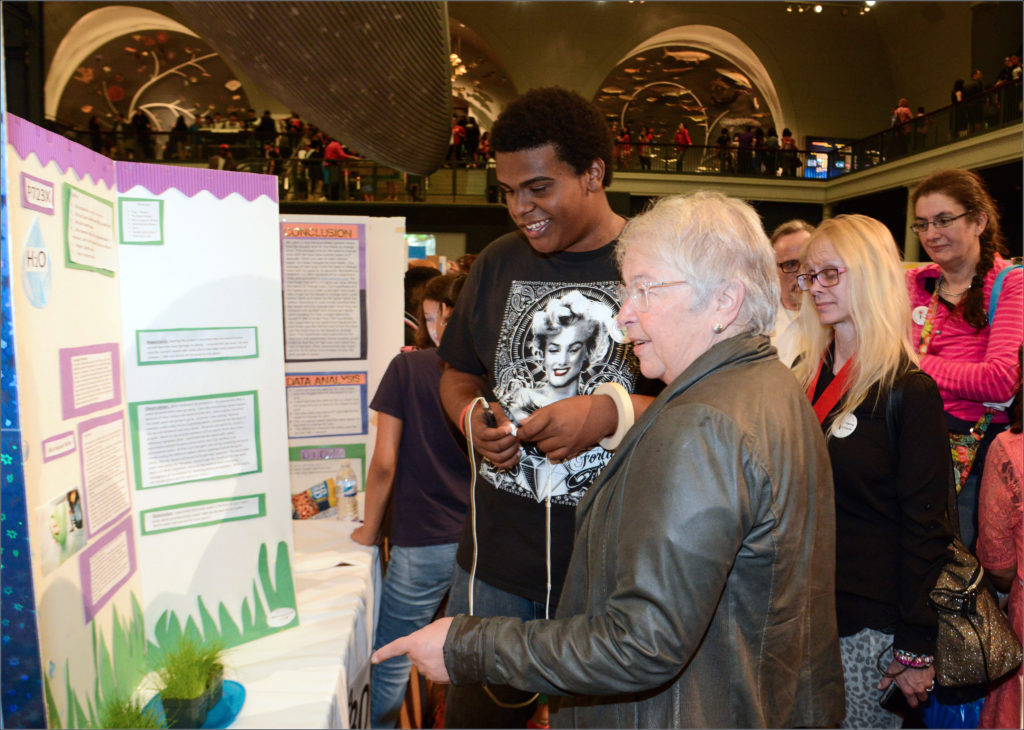
URBAN ADVANTAGE MIDDLE SCHOOL SCIENCE INITIATIVE
Urban Advantage (UA) is a New York City science initiative that leverages the expertise and resources of science-based members of the CIG to enhance student performance and teacher’s skills and resources. Urban Advantage reflects the belief that it is an advantage to live in a city with world-class cultural institutions and resources.
Launched in 2004, program partners include the American Natural History Museum, Brooklyn Botanic Garden, New York Botanical Garden, New York Hall of Science, Queens Botanical Garden, Staten Island Zoological Society, the Wildlife Conservation Society’s Bronx Zoo and New York Aquarium, and the New York City Department of Education.
Urban Advantage takes a holistic approach to developing scientific thinking to all by providing STEM experiences and resources to public schools, many of which are in underserved communities. Hands-on experiences for students are paired with professional development for teachers, equipment for schools, and in and out-of- school access to UA partner institutions through free school and family field trips and activities.
Outreach is conducted in multiple languages, and parent coordinators are used to inform families of the UA benefits. The UA program serves all five boroughs and includes participation from over 20% of the New York City schools with 8th grade students. The UA program has grown to serve 123 active schools and 364 science teachers.
Currently the program reaches almost 34,000 students.
WHAT WE CAN LEARN
Urban Advantage couples in and out-of-school experiences to ensure that students are exposed to scientific inquiry and resources through field trips and projects at New York’s best science institutions, as well as through programs and equipment in their school.
By providing free access to families of students, the UA program increases access to resources for those that might not otherwise be able to afford admissions prices or programs.
Integrated professional education for teachers increases the quality of teaching and resources not only for students in the program, but all students served by a particular teacher.
PROFILE
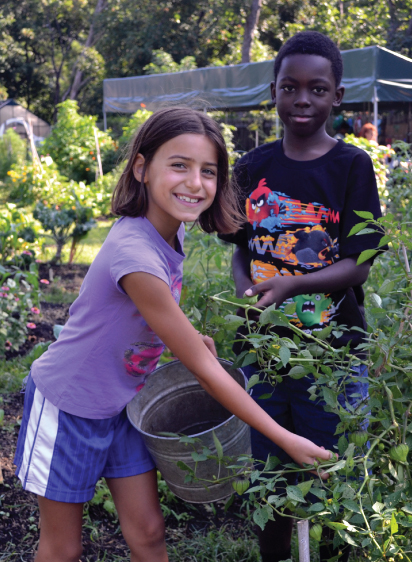
SONAL BHATT
Vice President of Education and Interpretation
Brooklyn Botanic Garden
As the neighborhoods around us have changed over the years, Brooklyn Botanic Garden remains steadfast and dedicated to connecting our communities with the wonderful world of plants.
Whether people come simply to find a moment’s peace, to disconnect from our intensely urban surroundings and get back to nature, to see something beautiful, to inspire their own work, or to learn something new.
It is vital that the cultural plan is inclusive of science and the environment and emphasizes their importance to the culture of New York City. The environment is an important part of our cultural heritage, and horticulture is an applied science that reflects arts and culture.
The future of a sustainable and livable New York depends on green spaces and nature.

